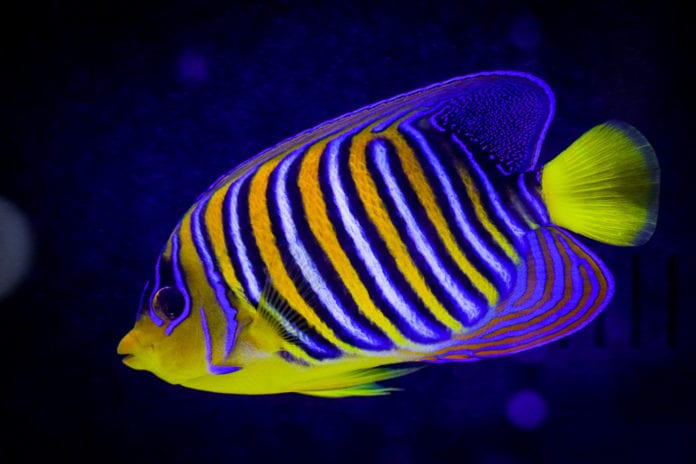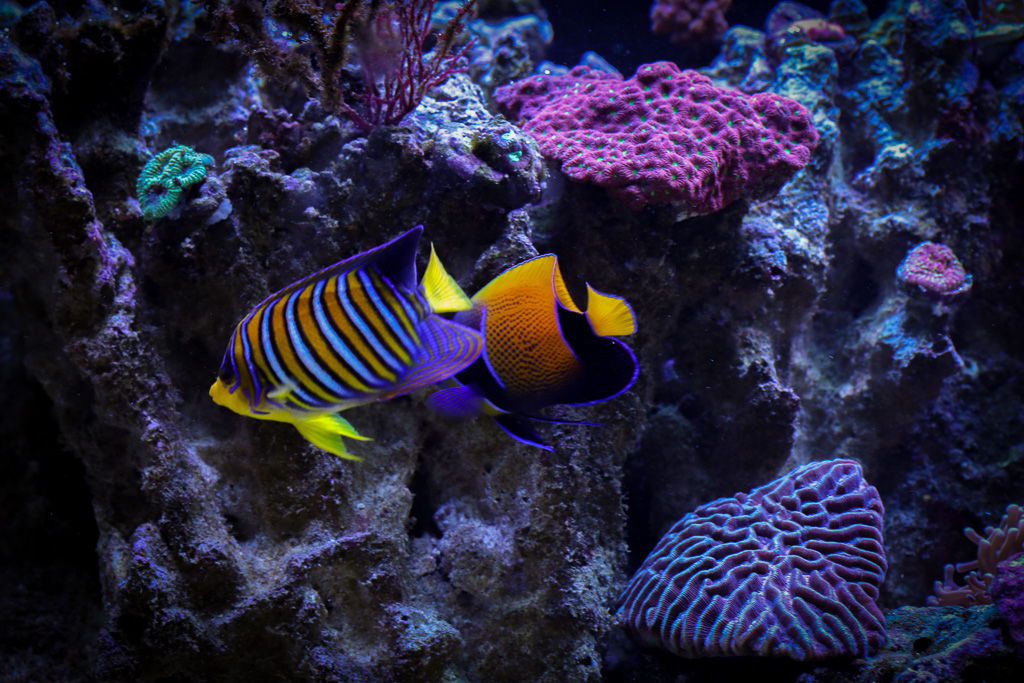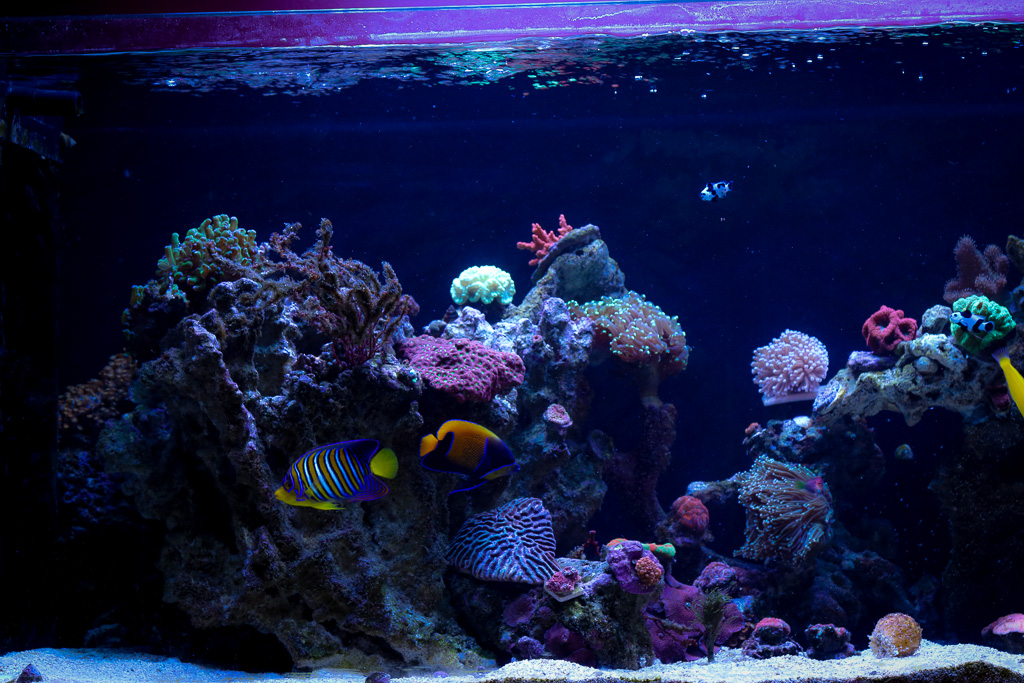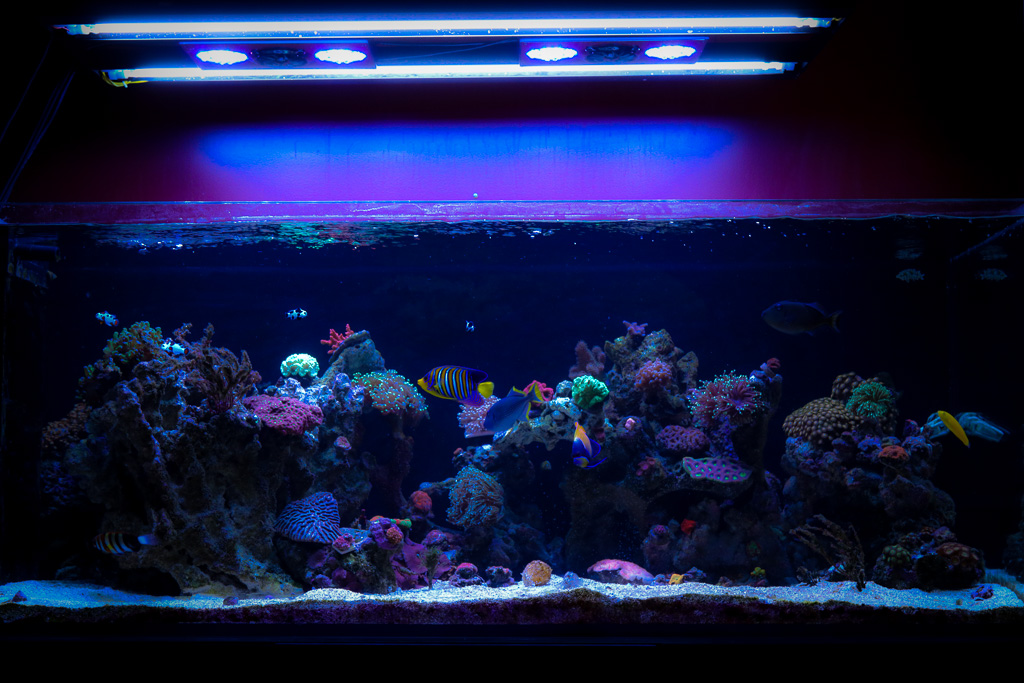Reef Safe Large Angelfish?
Are there any reef safe large angelfish? It’s a common question for saltwater aquarists. Angelfish such as the Emperor Angel, Majestic Angel, Regal Angel, etc. are relatively common in FOWLR setups. While some species are more prone to nip at coral and inverts than others, there are a few that are completely reef safe. Angels from the Genicanthus genus are as reef safe as it gets with angels. Some of the more common species available include;
- Lamark’s Angelfish
- Spotbreast Angelfish
- Watanabei Angelfish
- Bellus Angelfish
All other genera are prone to nipping at coral and or eating sessile inverts. Furthermore, there are a few species that will always nip at coral and are known as “not reef safe large angelfish” such as the French Angelfish. Marine angelfish come from the family Pomacanthidae. Within the family there are 8 genera and almost 100 total species;
- Apolemichthys ( Banded Angelfish, Griffis Angelfish, etc)
- Centropyge ( Dwarf Angelfish – Coral Beauty, Flame Angel, etc.)
- Chaetodontoplus ( Scribbled Angelfish, Black-Velvet Angelfish, etc.)
- Genicanthus ( Japanese Swallowtail, Bellus Angel, etc.)
- Holacanthus (Queen Angelfish, Rock Beauty Angelfish, etc.)
- Paracentropyge (Multibarred Angelfish)
- Pomacanthus ( Emperor Angelfish, Blueface Angel, Cortez Angel, etc.)
- Pygoplites ( Regal Angelfish )
Many species of the genera mentioned above are known coral eaters. With that being said, most specimens have their own unique tendencies. Some will eat coral with no hesitation at all and some will ignore coral completely. The Emperor Angelfish is a species within the popular Pomacanthus genus, which also includes the Blueface Angel, Majestic Angel, French Angel, Yellowbar Angel, etc.
Most of these angels are hit or miss when it comes to nipping. For example, occasionally the Emperor Angelfish has been seen in large reef tanks. After a month of research I had my first juvenile Emperor Angelfish. It only made it one week in my reef tank before I gave it away to my LFS. Once the fish was acclimated it began to size up the LPS coral in my tank. Five days in and it was nipping at basically everything. Below is an image of the Juvenile Imperator sizing up a Wilsoni frag.
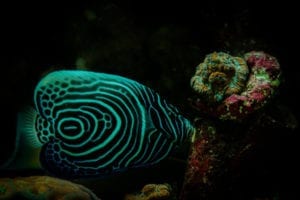
Large Angels In Personal Reef Tank
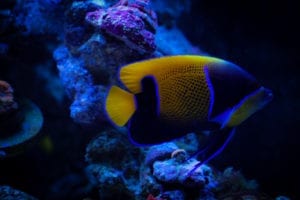
Reef tanks between 175-225 gallons are capable of maintaining most large angelfish species. The Majestic Angel or Blue Girdled Angelfish is a personal favorite. It’s one of the smaller members of the Pomacanthus genus. It only grows to around 12 inches and usually less in a captive environment. They also grow very slowly and can live more that 20 years. The Majestic Angel is reasonably hardy although it can be difficult to acclimate. The Majestic Angel also needs pristine water conditions. As will all large angelfish, an efficient protein skimmer is essential.
A large variety of foods should be given such as Nori seaweed strips, Mysis Shrimp, fortified Brine Shrimp and specialty marine angelfish preparations containing sponge. Ideally any Majestic Angelfish owner will have an ample supply of natural algae and sponge within their aquarium. It is advisable to keep only one Majestic Angel per tank unless the system is several hundred gallons. They are generally peaceful towards all other fish except conspecifics and other large angels. They are known to pick at LPS coral while leaving SPS coral and noxious corals alone.
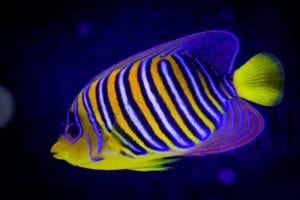
My personal favorite large Angel is the Regal Angelfish. The Regal Angelfish is one of the most beautiful fish available in the hobby today. Unfortunately, they are also amongst the hardest to keep. They are difficult to acclimate and maintain. There are several different varieties. The Indo and South Pacific variety has a grey/blueish belly, while the Indian Ocean and Red Sea varieties have orange/yellow bellies. Indo and South Pacific Regal Angelfish should be avoided. Due to adverse collection and shipping methods they are not as hardy as their Indian and Red Sea counterparts.
This is one of the smaller large angelfish. It can grow up to a maximum of 10 inches. A 125 gallon or preferably larger aquarium is necessary for long term health. The Regal Angelfish needs a mature tank with pristine water conditions, complete with live rock, natural algae for grazing and naturally occuring sponge. The Regal Angelfish is notoriously hard to get eating and very shy. These angels will not do well in a tank with larger angels or large aggressive fish such as triggers and tangs.
A wide variety of foods are often necessary to entice a feeding response. Mysis Shrimp, fortified Brine Shrimp, clams on the half shell, mussels and seaweed strips are common choices. It may take 3 days to a week to get a Regal Angelfish to eat if at all. They require the highest standards of water quality as well as a peaceful and calm aquarium. The Regal Angel is infamous for picking at coral, especially Zoanthids and Palythoa.
Tips For Keeping Large Angelfish In A Reef Tank
*disclaimer: Each individual angelfish will have its own personality and habits. Proceed with caution as there is no guarantee of a completely reef safe large angel. This article represents actions taken to minimize risk and best practices for keeping a large angelfish in a reef tank. This is in no way a promise of a reef safe large angelfish with any degree of certainty.
As seen in the images below I have a Majestic Angelfish and a Regal Angelfish in a mixed reef tank. There are no guarantees and both of these large angels could revert back to their basic instincts at any time, however these practices currently minimize the risk substantially. As with any large angel in a reef tank, prepare to move the coral or fish at a moments notice should they nip at any coral.
Low Stress Environment – This is self explanatory for an intermediate or advanced aquarist and includes many different factors. A low stress environment in this case pertains to tank mates. Both the Regal Angelfish and Majestic Angelfish are shy and retreat easily. Larger aggressive tank mates can reduce angels to hiding most of the time, hindering their ability to eat and graze normally. Overstocking is also a general concern. Crowding in an aquarium will denigrate the water quality as well as stress out the inhabitants, often to their peril. Also of note, I continuously observe the Regal Angel as a peaceful inhabitant, even to the Majestic Angel. The one exception is any similar fish in terms of size that has stripes. My Regal will chase the resident Harlequin Tusk if it gets too close. Too many fish with stripes may have a detrimental effect on the overall health of the fish.Diet – The Majestic Angelfish and Regal Angelfish in my tank are fed a varied diet of clams on the half shell, fortified Brine Shrimp, Mysis Shrimp and a specialty frozen angelfish formula, which contains sponge. Sponge is critical in maintaining health in most marine angelfish. A decent amount of natural algae and sponge is also present within the aquarium for additional grazing. In terms of preference, frozen specialty angelfish specific food with sponge and clams on the halfshell are eaten with gusto by my Regal Angelfish and Majestic Angelfish.
Feed small portions often throughout the day. Mine are fed smaller portions 3-5 times per day. Since angelfish are constantly grazing my hypothesis is that angels are less prone to nipping at coral if they are reasonably well fed sparingly within the LED lighting schedule. Also, their diet varies on a daily basis between different frozen preparations. In essence, the theory is that a varied diet will reduce boredom and the urge to nip at coral for different sources of nutrition. Secondary benefits include knowing which food source your angel’s favorite. This is especially helpful if your angel isn’t eating due to sickness or stress. For example, enriched Brine Shrimp is preferable to the Majestic Angel while my Regal Angel enjoys frozen angel preparations with sponge.
Size – Acquire your large angelfish as smaller juveniles in comparison to adults. Angels that are not too small and fragile and not too big and set in their ways are generally more adaptive to aquarium life.
Learn more about caring for Angelfish

